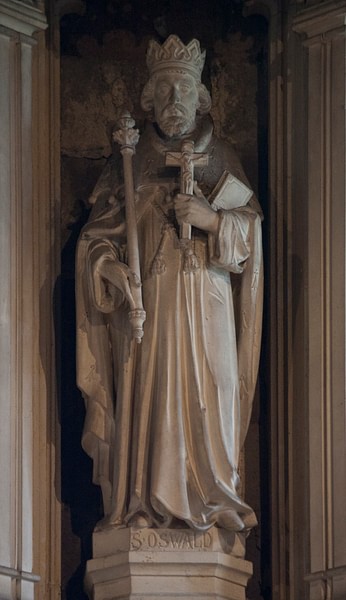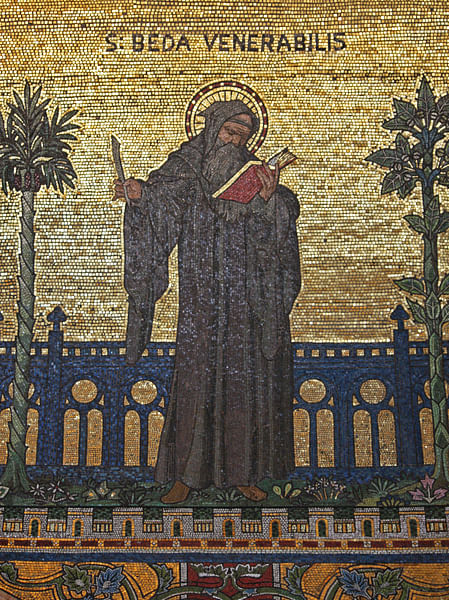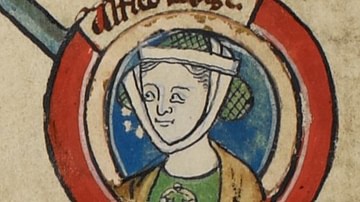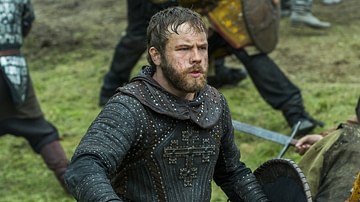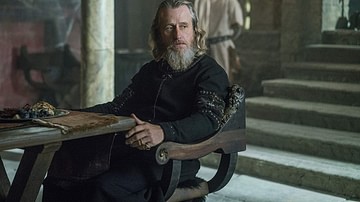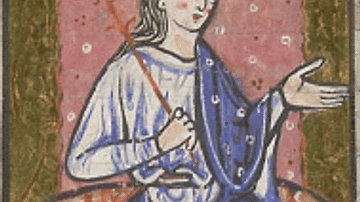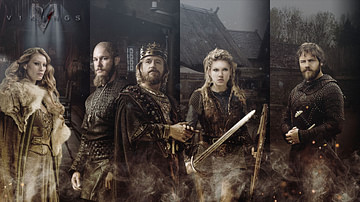
The Kingdom of Northumbria (c. 604-954 CE) was a political entity in the north of modern-day Britain with Mercia directly to the south, the Kingdoms of the Welsh to the west, and the land of the Picts to the north; the eastern line of the kingdom was bordered by the sea. The region was originally divided between the two kingdoms of Bernicia (in the north) and Deira (south) but the people were referred to as Northumbrians, (meaning “those north of the Humber River”). These two kingdoms often fought against each other until they were united under the reign of Aethelfrith (r. 593-616 CE) but their rivalry would continually destabilize the region throughout its history.
There were frequent conflicts between Northumbria and the Kingdom of Mercia over the years with one or the other maintaining supremacy at one time or another. Both were made subjects of the Kingdom of Wessex between 825-829 CE in the reign of Egbert of Wessex (r. 802-839 CE). Northumbria was later dominated by the Norse following the invasion of the Great Heathen Army of Vikings in 865 CE and was finally absorbed into the Kingdom of the English by Eadred of Wessex (r.946-955 CE) in 954 CE.
The dates for the Kingdom of Northumbria are often given as 654-954 CE; 654 CE as the date Oswiu (r. 642-670 CE) united Bernicia and Deira and 954 CE as the date Eadred defeated the last Norse king of Northumbria, Eric Bloodaxe (r. 947-948, 952-954 CE) and brought Northumbria under English rule. A more accurate dating would be 547-954 CE since the kingdom was first founded by Ida the Flamebearer (r. c. 547-599 CE) or, more precisely, c. 604-954 CE since Bernicia and Deira were first unified under Aethelfrith, not Oswiu.
Unification Under Aethelfrith
Ida was the first king of Bernicia; he may have initiated the conflict with Deira by expanding his kingdom toward the south. Aethelfrith, grandson of Ida, expanded his kingdom through military conquest and repopulating formerly British regions with citizens from Bernicia. In c. 600 CE he defeated the Britons decisively at the Battle of Catraeth (a tragic defeat for the British forces commemorated in the 13th century CE Welsh poem Y Gododdin) and by 604 CE had control of Deira and united it with Bernicia.
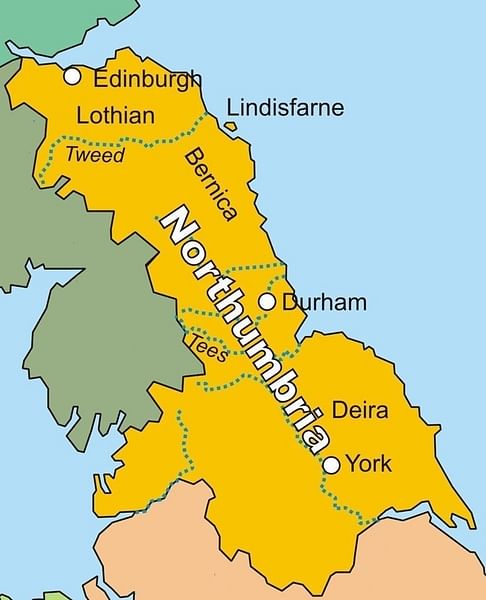
To the south, the Kingdom of Mercia had also been expanding and, in c. 616 CE, this may have provoked a reaction from Aethelfrith. The circumstances surrounding the Battle of Chester are unclear but Aethelfrith defeated the combined forces of the Welsh kingdoms of Powys and Rhos which may have been supported by king Cearl of Mercia (r. c. 606-c.625 CE). Aethelfrith died shortly after this conflict in the Battle of Bawtry on the River Idle against East Anglia.
Northumbrian Collapse
When Aethelfrith united Bernicia and Deira, he disinherited the ruling house of Deira, notably Prince Edwin (r. 616-633 CE), the son of King Aelle of Deira (r. 560 CE). Aethelfrith encouraged unity of the two kingdoms by marrying Edwin's sister Acha, but Edwin recognized that he posed a threat to Aethelfrith's reign and wisely fled Northumbria. Aethelfrith did, in fact, want Edwin killed but the prince was given sanctuary in the kingdoms of East Anglia, of the Welsh, and Mercia. It is possible, in fact, that the battles of Chester and Bawtry had to do with those kingdoms protecting his rival.
Scholar Roger Collins has observed how few historical records survive from the Kingdom of Mercia due to the wars with Wessex and the Viking invasions and goes on to note, “the conflicts of the ninth and tenth centuries were in most respects to prove equally destructive in Northumbria, whose political stability had never been very secure” (194). Due to the loss of these records, many events in Northumbria's history are obscured and the last year of Aethelfrith's reign is among them.
When Aethelfrith died, Edwin returned from exile and claimed the throne, ruling from Deira. He capitalized on the gains made by Aethelfrith and expanded the kingdom further, prompting responses from Mercia and Wessex. In Wessex, King Cynegils (r. 611-643 CE) divided his kingdom in half, giving the north to his son Cwichelm (d. 636 CE) to create a buffer state should Northumbria attack. In 626 CE, Cwichelm sent an assassin to kill Edwin but the plot failed.
Edwin's response to the assassination attempt is still debated by scholars because there are no records supporting the later claim that he marched on Wessex. According to legend, Edwin's forces met the armies of Cynegils and Cwichelm, allied with those of Mercia under their king Penda (r. 625-655 CE), in 626 CE at the Battle of Win-and-Lose Hill. Although some modern-day scholars continue to insist this battle is a later fiction, archaeological evidence from the site (located in the Peak District) supports the historicity of the battle which Edwin won.
The Northumbrians drove Cynegils and Cwichelm back south and Penda broke his alliance with Wessex and attacked them in 628 CE, defeating Cynegils at the Battle of Cirencester, and taking large swaths of land. Penda then turned his attention to Northumbria, allied himself with the Welsh king Cadwallon ap Cadfan (r. c. 625-634 CE), and attacked. In 633 CE, he defeated Northumbria at the Battle of Hatfield Chase; Edwin and his son Osfrith were both killed and Northumbria's power collapsed.
Reunification Under Oswiu
Edwin had converted to Christianity in 627 CE, the first Northumbrian king to do so, and all the kings who succeeded him would be Christian. After his death, he was regarded as a martyr and then as a saint who had fought for the faith against the pagan Mercians under Penda. His successor, Oswald (son of Aethelfrith, r. 634-642 CE) would also be regarded as a saint after he fell in battle against Penda in 642 CE.
Oswald championed the Celtic form of Christianity. What exactly `Celtic Christianity' was is unclear and the details – and even the existence – of a different sort of Christianity which diverged markedly from Roman Catholicism is still debated. All that is clearly known is that followers of so-called Celtic Christianity celebrated Easter at a different date and the monks were tonsured (hair was cut) differently but, surely, there were more significant differences than these.
Oswald chose a devout Irish monk Aidan (later St. Aidan of Lindisfarne, d. 651 CE) as missionary to the people of Northumbria and Aidan began his work by building the famous monastery on Lindisfarne. Edwin had embraced the Roman version of Christianity which, however it differed from the Celtic, was considered enough of an error by Oswald that the people had to be brought back to the truth of Celtic Christianity.
These differences in the practice of Christianity may have played a part in the unification of Bernicia and Deira under Oswald's successor, Oswiu. Although united under Aethelfrith, Bernicia and Deira maintained their old rivalry and these differences seem to have worsened after Edwin's death. After Oswald was killed in the Battle of Maserfield, the kingdom was divided between his brother Oswiu at Bernicia and Oswine (son of Osric, Edwin's cousin, r. 633-634 CE) at Deira.
In c. 651 CE, Oswiu declared war on Oswine, though the reason for this is unclear. It could be, though, that differences in the practice of Christianity played a part. Oswiu was a Celtic Christian while Oswine is thought to have been Roman Catholic. Bede places the blame for the conflict on Oswiu but does not specify a reason for it. Oswine refused to fight, disbanded his army, and sought refuge with one of his earls who betrayed him to Oswiu and he was executed. Oswiu then claimed Deira and unified the two kingdoms as the single entity of Northumbria in 654 CE. The Christian connection to this unification, of course, is speculation owing to the lack of Northumbrian records.
Another theory regarding unification is that Oswiu felt Oswine was too weak to defend the region against Penda of Mercia. Oswald had beaten back an offensive by Penda during his reign but, during Oswine's, Penda took parts of the southern kingdom without any opposition. After assassinating Oswine and uniting the kingdoms, Oswiu built up his military and, in 655 CE, he defeated and killed Penda at the Battle of the Winwaed. He then divided Mercia in half; Oswiu ruled the north and left the south to Penda's son Peada (r. 655-656 CE).
Northumbria was again the most powerful kingdom in Britain (as it had been under Edwin) and Oswiu took the rest of Mercia in 656 CE after the death of Peada. He was driven out by Wulfhere (one of Penda's sons, r. 658-675 CE) in 658 CE but still held Northumbria. In 664 CE he presided over the Synod of Whitby which was called to resolve the differences between Roman Catholic and Celtic Christianity; he ruled in favor of Roman Catholicism as the official religion of Northumbria.
Whatever other consequences may have resulted from Whitby, one was an increase in churches, abbeys, and monasteries dedicated to saints of Rome (especially St. Peter) with attendant scriptoriums and libraries; these not only produced Illuminated Manuscripts but encouraged scholarship.
Literacy & Rise of Wessex
The Northumbrian focus on the practice of Christianity – far more intense at this time than in Wessex or Mercia – produced two of the finest scholars of the age: Bede (c. 672-735 CE) and Alcuin (c.735-804 CE). Bede is best known for his Ecclesiastical History of the English People (c. 731 CE), considered the first serious work on the history of Britain and earning Bede the epithet `Father of English History'.
Bede's work would not only provide the people of the region with the story of their past but would have far-reaching effects on how history as a whole was understood in the west. He popularized the use of the dating system of BC (Before Christ) and AD (Anno Domini, Latin for “In the Year of Our Lord”) which had been invented in c. 525 CE by the monk Dionysius Exiguus (c. 470-544 CE) in an effort to universalize the date of the celebration of Easter for all churches.
The monastery of Monkwermouth-Jarrow, where Bede lived and wrote, was the most important center of learning at the time and continued to be until the Viking raids of the 9th century CE. A monk of York, Ecgbert (later Archbishop Ecgbert of York, d. 766 CE) was either taught by Bede personally at Monkerwermouth-Jarrow or learned from him through correspondence. Either way, Bede was instrumental in the foundation of the archbishopric of York which produced the great scholar Alcuin.
Alcuin of York is still considered an intellectual giant of his day and would influence future generations of scholars as a teacher at the court of Charlemagne (King of the Franks 768-814 CE/Holy Roman Emperor 800-814 CE). He invented the concept of the word problem in mathematics and the use of the question mark in writing but, more importantly, emphasized the importance of literacy as an aspect of personal piety; this concept would later influence the educational reforms of Alfred the Great of Wessex (r. 871-899 CE).
Although the monasteries flourished during this time, the government was almost continuously unstable. Between c.735-c.802 CE, Northumbria had over ten kings in fairly quick succession, most of whom were disposed of by rivals. The great advances made by earlier kings in expanding the kingdom and building projects were undermined by the resurgent rivalry between Bernicia and Deira. In 829 CE, Northumbria submitted to Egbert of Wessex as overlord and Egbert, who had previously defeated Mercia in 825 CE, now ruled over the three greatest kingdoms in the land.
The Viking Raids & Norse Rule
Egbert's supremacy was soon challenged, however, as Viking raids increased in Britain. The first Viking raid struck Northumbria in 793 CE at Lindisfarne where they sacked the monastery and murdered the monks. The next year they returned to sack the monastery at Jarrow and the year after that Iona fell to them. Egbert was defeated by a Viking army at Charmouth in 836 CE but won against a coalition of Vikings and Dumnonians in 838 CE. His son Aethelwulf (r. 839-858 CE) would also endure Viking onslaughts during his reign.

In 865 CE, the Vikings halted their practice of periodic hit-and-run raids and invaded Britain in full force. The Great Heathen Army, as it was called by medieval scribes, landed at East Anglia and subdued it and then marched on Northumbria, conquered it, and then took most of Mercia. Northumbria seems to have been taken easily because of conflict between two kings, neither of whose dates are known: Osberht and Aelle.
It is likely that these two respectively represented the interests of Bernicia and Deira but this is unclear. Osberht was deposed by Aelle in c. 865 CE; he was claimed by later historians to have usurped the throne. Aelle is featured in the Icelandic saga The Tale of Ragnar's Sons (late 13th/early 14th century CE) which is a sequel to the Icelandic epic The Saga of Ragnar Lothbrok (13th century CE), featuring the legendary Viking chieftain. In The Tale of Ragnar's Sons, Aelle defeats and kills Ragnar by throwing him into a pit of snakes. His sons then avenge their father's death by defeating Aelle's army and inflicting the torture of the blood eagle on him. After his death, Ivar the Boneless reigns as king of Northumbria.
Records from the historical Aelle's time are nearly non-existent but it seems that he and Osberht put aside their differences and met the Viking invasion with their combined forces in March of 867 CE at York. The Northumbrian kings were both killed in the battle and their armies scattered. The Vikings installed a puppet-king, Ecgberht I (r. c. 867-873 CE) who was deposed in 873 CE by the Northumbrians who then chose Ricsige (r.873-876 CE) as king.
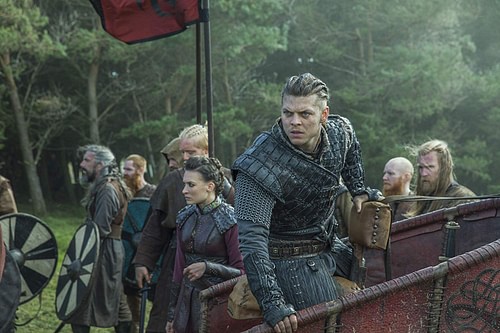
Ricsige was overthrown by Halfdan Ragnarson (r. 876-877 CE), one of the leaders of the Great Heathen Army and, after him, Northumbria was ruled by the Norse until 954 CE when Eric Bloodaxe was deposed by Eadred. Aethelstan of Wessex, the first King of the English (r. 927-939 CE) held Northumbria during his reign but after his death it reverted back to Norse rule under Olaf Guthfrithson (r. 839-841 CE), the Viking king of Dublin and grandson of the infamous Viking chief Bardr mac Imair (or possibly one of his brothers). Eadred's overthrow of Eric Bloodaxe ended Norse rule in Northumbria and joined the region to the rest of Britain.
Northumbria in Vikings & Legacy
Northumbria is featured in the TV series Vikings through the character of King Aelle (played by actor Ivan Kaye) and his daughter Judith (played by Jennie Jacques). In the show, Aelle forges an alliance with Ecbert of Wessex through a marriage between Judith and Ecbert's son Aethelwulf. Judith betrays Aethelwulf through an affair with the former Viking-turned-cleric Athelstan resulting in the birth of Alfred the Great. Ecbert enlists the aid of Ragnar Lothbrok as a mercenary in his attempt to dominate Mercia and Ragnar is later captured and killed by Aelle who is then killed by Ragnar's sons.
None of these events are in any way historical. As noted, almost nothing is known of Aelle's reign in Northumbria and he would probably not even be remembered were it not for the role he plays in The Tale of Ragnar's Sons. Aethelwulf's wife and the mother of Alfred the Great was Osburh of Wessex who died in c. 854 CE. Judith, Aethelwulf's second wife, was the daughter of Charles the Bald (r. 843-877 CE), King of West Francia and was a teenager when they were married c. 855 CE; they never had any children.
Northumbria plays a relatively minor role in Vikings but, in history, its contributions were significant. The kingdom experienced only a few periods of real stability but, in spite of this, still made significant advancements in religion which resulted in developments in education, architecture, and art, among other disciplines.
At least four of the greatest Illuminated Manuscripts – The Book of Durrow, The Codex Amiatinus, The Lindisfarne Gospels, and The Westminster Abbey Bestiary – all come from Northumbria as did two of the greatest scholars of the medieval world. Although the kingdom expended enormous effort on military conflict internally and externally, its greatest contributions had nothing to do with war but with the elevation of the human spirit.
